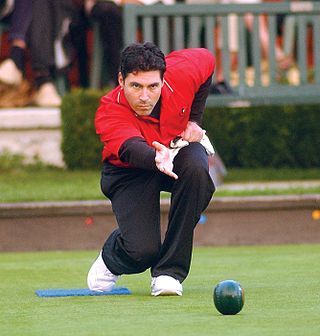
Bowls, also known as lawn bowls or lawn bowling, is a sport in which the objective is to roll biased balls so that they stop close to a smaller ball called a "jack" or "kitty". It is played on a bowling green, which may be flat or convex or uneven. It is normally played outdoors and the outdoor surface is either natural grass, artificial turf or cotula.

Bocce, sometimes anglicized as bocce ball, bocci, or boccie, is a ball sport belonging to the boules family. Developed into its present form in Italy, it is closely related to British bowls and French pétanque, with a common ancestry from ancient games played in the Roman Empire. Bocce is played around Western, Southern, and Southeastern Europe, as well as in overseas areas with historical Italian immigrant population, including Australia, North America, and South America, principally Argentina and the southern Brazilian states of Rio Grande do Sul and Santa Catarina. Initially it was only played by the Italian immigrants, the game has slowly become more popular among their descendants and more people around the world.

Skittles is a historical lawn game and target sport of European origin, from which the modern sport of nine-pin bowling is descended. In regions of the United Kingdom and Ireland the game remains as a popular indoor pub game.

A bowling green is a finely laid, close-mown and rolled stretch of turf for playing the game of bowls.
Sport has always been important in Birmingham, England, from the hundreds of diverse grass-roots sports clubs to internationally famous teams, associations and venues.

Lawn bowls at the 2005 Southeast Asian Games took place in the Hidden Vale Sports Club in Angeles City, Philippines.
Carpet bowls is a variant of lawn bowls played indoors. Originating in England, it is played particularly in the South of England, although it is played at League and County level in East Anglia, the Midlands and the North. There are also a few players in Eastern Townships, Quebec, Canada. Despite the name, carpet bowls is not just a trivial indoor game played at home.
David John Bryant was a three-times World (outdoors) singles bowls champion, a three-times World indoors singles champion and a four times Commonwealth Games singles gold medallist. He is generally considered to be the greatest bowler of all time, winning 19 World and Commonwealth gold medals in total.

Bowling is a target sport and recreational activity in which a player rolls a ball toward pins or another target. The term bowling usually refers to pin bowling, though in the United Kingdom and Commonwealth countries, bowling could also refer to target bowling, such as lawn bowls.
New Zealand Indoor Bowls (NZIB) is a form of Indoor bowls that is a highly competitive strategic sport. As its only international fixture is a Trans-Tasman event played under Trans-Tasman rules, it is a sport unique to New Zealand.
The Welsh Indoor Bowls Association (WIBA) is the governing body for the indoor bowling clubs in Wales. It has 24 affiliated clubs. The WBA organise competitions, including the WIBA Club Championship, and select and manage the national side.
The Welsh Ladies Indoor Bowling Association (WLIBA) is the governing body for the indoor bowling clubs in Wales. It has 25 affiliated clubs. The WLIBA organise national competitions and select and manage the national side.

Alex "Tattie" Marshall is record breaking Scottish bowls player.

The Bowls Premier League (BPL) is a biannual bowls competition involving teams from around Australia. The competition was founded in 2013 as a way to popularise the sport by presenting in a modernised format, using the term "made-for-television" in its promotion. The competition features faster play, modified rules, colourful clothing and comprehensive television coverage.
This page is a glossary of Bowls terminology.
Crown green bowls is a code of bowls played outdoors on a grass or artificial turf surface known as a bowling green. The sport's name is derived from the intentionally convex or uneven nature of the bowling green which is traditionally formed with a raised centre known as the crown.
The Short Mat Players Tour (SMPT) is a semi-professional short mat bowling organisation, that runs singles events through Europe. The tour was the first set of events to create a world ranking for short mat bowls. Events are generally set up in round robin format, with players progressing to a knockout round dependent on their position within their own group. In addition to traditional 4-wood singles events, the SMPT have also run pairs, fours, double-rink and two-wood singles competitions.
World Bowls is an international sport federation of Bowls. World Bowls is one of several bowls organisations that administer bowls around the world and is responsible for the sports premier event, the World Bowls Championship which historically was held every four years but from 2023 will take place every two years.







